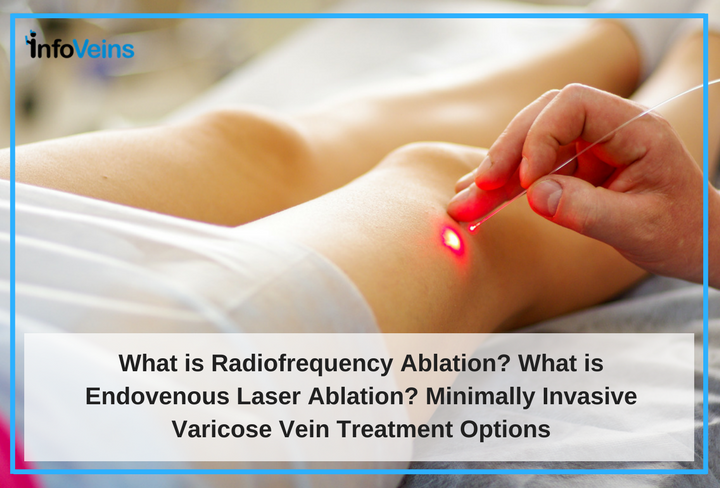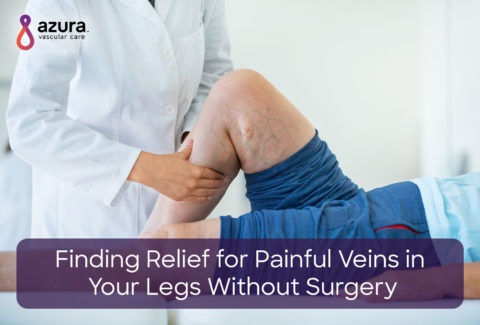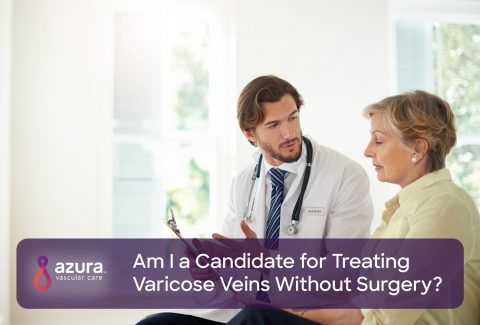
Wait…radiofrequency or a laser can be used for varicose veins treatment? It may seem like science fiction, but believe it or not, it’s true.
Varicose veins are a common problem.i And if you’re like many people who suffer from them, you may be wondering what, if anything, can be done about them.
Understanding the Basics of Varicose Veins
Varicose veins are caused by leaky one-way valves inside of the veins. The leaky valves allow blood to pool in the veins and push against the walls, which may already be weak. As a result of the pooling and pressure, the veins enlarge, and what you see is blue bulging veins on your legs – varicose veins.
While not always a serious condition, they can be. You should talk to your doctor about treating your varicose veins if you’ve experienced:
- Leg swelling
- A burning or throbbing feeling in your legs
- A heaviness or discomfort in your legs
- A sore or ulcer that is not healing
- Problems with blood clots in your
There is good news, though. Varicose veins can be treated several different ways. Surgery is one option, or there are several minimally invasive alternatives to surgery that you may consider.
Here we’ll we will cover what you need to know about the treatment options known as radiofrequency ablation and endovenous laser ablation.
Varicose Vein Treatment Options – What You Need to Know
Before you decide on which treatment is right for you, you should know that you have some choices. Keep in mind that not all treatments will work for everyone with varicose veins. Surgery has been an option for years, but there are now minimally invasive options such as radiofrequency ablation and endovenous laser ablation, which are proven effective and safe as well.i
Before we go into detail, be aware that your health insurance plan may want you to try some more conservative measures before you have surgery, endovenous treatments or any other minimally invasive treatment.i For example, you may want to try:
- Walking or exercising regularly
- Losing weight if you are overweight or obese
- Elevating your legs above the level of your heart several times a day for 30 minutes at a time
- Wearing compression stockings
Check out our dedicated article to varicose veins treatment options if you would like to learn more.
What is Radiofrequency Ablation? What is Endovenous Laser Ablation?
Endovenous procedures are treatments that occur within the veins. Radiofrequency or laser energy is used to heat and irritate the inside of the vein, causing it to scar and, eventually, clot off. This redirects blood flow to other healthy veins. While this can lead to improving the appearance of varicose veins, it is also particularly helpful to treat painful or uncomfortable leg symptoms that can be the result of varicose veins.ii
The Procedure
Endovenous ablation, whether using radiofrequency or a laser, is a special procedure performed by an Interventional Radiologist, a doctor who has been trained to use ultrasound and x-rays to treat diseases without surgery.
You don’t need to go to a hospital to have this treatment. You’ll want to discuss your medications, supplements, allergies and medical history with your Interventional Radiologist before the procedure.
On the day of your treatment, you should wear comfortable, loose clothing and have someone with you who can drive you home. A typical treatment will involve the following steps:
- A special numbing cream will be rubbed on the skin around your vein
- To help prevent infection, your leg will be thoroughly scrubbed before the procedure
- A small amount of a local anesthetic will be injected around the vein
- A small nick is made in the skin and then a thin tube called a catheter will be placed in into your vein
- Ultrasound is used to guide the path of the catheter
- Once the tip of the catheter is in the correct place in the vein, a laser fiber or radiofrequency tip is placed within the vein
- Numbing medication is injected directly in the vein, and then the inside of the vein is heated by the laser fiber, or by radio waves
- When the treatment is done, the catheter is removed and pressure is used to prevent control any bleeding
- A small bandage is placed over the puncture site
- You will need to wear compression stockings after the procedure
- The procedure takes about one hour, and you can resume your normal activities right awayii
Benefits
Endovenous radiofrequency ablation and laser ablation are effective treatments for varicose veins. Within 1 year, the veins are closed off between 91 and 100% of the time.iii There is less pain and an overall easier recovery compared to surgical treatment of varicose veins.i
Risks
All medical procedures have some risk. In addition to infection, which can happen with any procedure, risks that are specific to endovenous treatment may include:
- Bleeding or bruising at catheter site
- Bruise and pain around the treated vein – compression can help with this
- Inflammation and clotting of the vein, or thrombophlebitis, which can be treated with over-the-counter anti-inflammatory medications
- Very rarely, blood clots can form that need immediate medical attentionii
Who Should Not Have Endovenous Ablation?
You should not have endovenous ablation if:
- You are pregnant
- You have an active blood clot or a history of blood clots
- You have a skin infection over the vein
- You have limited ability to moveii
Endovenous radiofrequency ablation and laser ablation may be excellent option for you. If you have large varicose veins that are causing you problems, and you are hoping to avoid surgery, set up a consultation with an Interventional Radiologist who specializes in endovenous treatment of varicose veins today.
Sources:
iLin, F., Zhang, S., Sun, Y., Ren, S., Liu, P., The Management of Varicose Veins. Int Surg, 2015. 100: p. 185-189. https://www.ncbi.nlm.nih.gov/pmc/articles/PMC4301287/
iiRadiologyinfo.org, Varicose Vein Treatment (Endvenous Ablation of Varicose Veins). http://www.radiologyinfo.org/en/info.cfm?pg=varicoseabl (Reviewed 3/21/2016, accessed 12/8/2016)
iii Spinedi, L., Uthoff, H., Partovi, S., Staub, D. Varicosities of the lower extremity, new approaches: cosmetic or therapeutic needs? Swiss Med Wkly, 2016. 146:214360 http://www.smw.ch/scripts/stream_pdf.php?doi=smw-2016-14360


